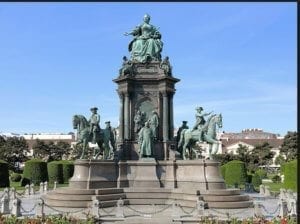
A massive statue in Vienna shows the empress Maria Theresia, imperial in bronze as she had been in life, surrounded by her generals and by an ennobled Dutch physician, the Baron Gerard van Swieten. She had recruited him from the medical department of the great Herman Boerhaave in Leiden, and he had come to Vienna in 1745 to reform Austria’s stagnant medical education and healthcare system, and to be her personal physician and medical confidante.
Van Swieten came from a fairly wealthy family in Leiden. Orphaned at the age of ten, he was sent two years later to the University of Louvain to study natural history and law. It is said that he also became proficient in eight languages. At eighteen, he enrolled in the faculty of medicine in Leiden, studying under Boerhaave, graduating in 1725, staying on as Boerhaave’s assistant, but facing substantial opposition in becoming his successor because he was a Catholic in a Protestant country. So at the age of forty-five, he decided to accept Maria Theresia’s offer. Appointed Promedicus and Bibliothecarius, he moved to Vienna.
There had long been in Vienna a university and a medical school. Duke Rudolph IV of Austria had founded it in 1365 by papal permission. It was to be based on the rules and customs first observed at Athens and later at Rome and Paris. For the first four hundred years, students had to learn by rote the works of Galen and Avicenna, guided by practicing physicians who would give them long-winded discourses but never exposed them to a patient or a dissecting room. As modern medical schools arose in other parts of Europe, foreign students no longer went to Vienna. Wealthy Austrians went abroad to study in France or Italy. By 1703, standards had become so low that medical degrees were no longer being awarded in Vienna.
In 1740, Maria Theresia came to the throne of a great empire that now incorporated parts of the Netherlands and Italy with flourishing medical schools. Realizing that changes were needed, she sought the advice of Herman Boerhaave, at that time the most esteemed doctor in Europe. Boerhaave recommended Gerard van Swieten, his talented assistant, who arrived in Vienna in 1745 and promptly set about his task of reforming an archaic ossified system. He began by getting rid of the obstructive influence of the Jesuits over education. He introduced regular instruction in anatomy and dissections and created the first teaching hospital, at first with only twelve beds. Students learned to take a history, examine the patient, and keep detailed medical records. They were taught to prescribe a healthy diet and hygienic regimens instead of the absurd and often harmful polypharmacy then in vogue. Clinical instruction at the bedside was begun in 1754, and the library, of which he was in charge, opened to the public.
Van Swieten appointed professors at the university, instituted government-supervised examinations, and reformed pharmacy inspections. He founded a botanical garden and a chemical laboratory. Despite his extensive duties, he made time for scientific work and wrote on epidemics, aphasia, bladder stones, rabies, episodic cluster headache, and the treatment of syphilis and of gout. For thirty years, he published in Latin the commentaries and aphorisms of his former chief, and has been justly called Boerhaave’s Boswell.
He was also assigned to deal with the century old rituals that peasants employed to protect themselves against vampires. These superstitions were prevalent in Moravia, Serbia, and Bosnia, in particular in the parts annexed by Austria after defeating the Turks. Sent to investigate this matter, Van Swieten ended up by publishing a discourse denying the existence of these unwanted nightly visitors. This resulted in the empress issuing a degree banning the myriads of traditional rituals used by peasants such as deploying garlic, hanging up fish-nets or rowan crosses, or driving stakes into graves.
Van Swieten died in 1772. His reforms had a lasting effect and he is justly regarded as the founder of the so-called first Vienna school, which exerted a profound influence on the history of medicine.

Leave a Reply